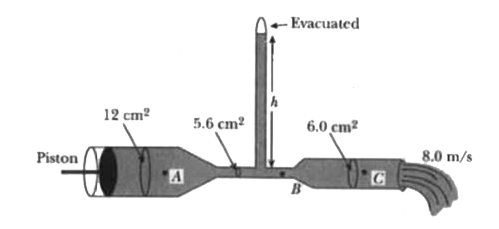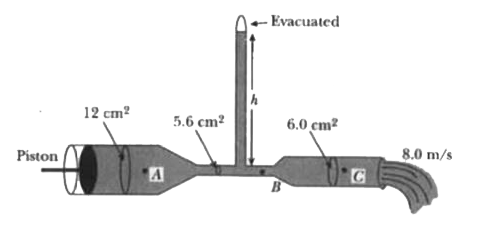A passenger plane flies at an altitude of 8 km at a speed of 900 km/h. The speed is measured with the aid of a Pitot-Prandtl tube. Find the pressure difference in the differential manometer. For data relating to the atmosphere see ξ26.10, Table 26.3.
The correct Answer is:1.65×104 Pa = 124 mm Hg
Similar Questions
Measurements carried out by the Soviet "Venus" space-probes with the aid of their landing modules have shown that from an altitude of 50 km above the surface of Venus the temperature of the planet's atmosphere changes linearly as the altitude decreases. Using the data given below prove that this layer of the atmosphere consists mainly of carbon dioxide gas.
Altitude above surface h, km504237150Pressure p,atm13.363790Temperature t,∘C80160200360485T,K353433473633758
View SolutionFind the lifting force of a balloon of 2×104m3 capacity filled with helium at the surface of the Earth and at an altitude of 10 km above sea level. The balloon's envelope is open underneath. For data on the properties of the Earth's atmosphere see ξ26.10, Table.
View Solution
Knowledge Check
A glass tube has several different cross-sectional areas with the values indicated in the figure . A piston at the left end of the tube exerts pressure so that mercury within the tube flows from the right end with a speed of 8.0 m/s . Three points with in the tube are labeled A , B and C . (Atmospheric pressure is 1.01×105N/m2 , Density of mercury is 13600kg/m3) .

At what speed is mercury flowing past the point labeled B ?A2.27 m/sB7.47 m/sC4.27 m/sD8.57 m/sA glass tube has several different cross-sectional areas with the values indicated in the figure . A piston at the left end of the tube exerts pressure so that mercury within the tube flows from the right end with a speed of 8.0 m/s . Three points with in the tube are labeled A , B and C . (Atmospheric pressure is 1.01×105N/m2 , Density of mercury is 13600kg/m3) .

At what speed is mercury flowing past the point labeled A ?A4.0 m/sB2.0 m/sC8.0 m/sD12 m/sA glass tube has several different cross-sectional areas with the values indicated in the figure . A piston at the left end of the tube exerts pressure so that mercury within the tube flows from the right end with a speed of 8.0 m/s . Three points with in the tube are labeled A , B and C . (Atmospheric pressure is 1.01×105N/m2 , Density of mercury is 13600kg/m3) .

What is the total pressure at point B ?A1.01×105PaB4.27×105PaC3.64×104PaD6.44×104Pa
A fighter plane is pulling out for a dive at a speed of 900km/h. Assuming its path to be a vertical circle of radius 2000m and its mass to be 16000kg, find the force exerted by the air on it at the lowest point. Take g=9.8m/s2
View SolutionA fighter plane is pulling out for a dive at a speed of 900km/h. Assuming its path to be a vertical circle of radius 2000m and its mass to be 16000kg, find the force exerted by the air on it at the lowest point. Take g=9.8m/s2
View SolutionA fighter plane is pulling out for a dive at a speed of 900km/h. Assuming its path to be a vertical circle of radius 2000m and its mass to be 16000kg, find the force exerted by the air on it at the lowest point. Take g=9.8m/s2
View SolutionIn October 1971 an atomic clock was placed on a "Boeing 747" flying at an altitude of 10 km at a velocity of 1000 km/h eastwards. An identical clock, with time-keeping accuracy of 1 ns (1 nanosecond = 10−9) remained on the Earth. The plane was in flight 60 h, after which a comparison was made of the clocks' readings. What was the difference in the readings of the clocks in the plane and on the Earth? What were the contributions of the plane's elevation and its speed of flight?
View SolutionA glass tube has several different cross-sectional areas with the values indicated in the figure . A piston at the left end of the tube exerts pressure so that mercury within the tube flows from the right end with a speed of 8.0 m/s . Three points with in the tube are labeled A , B and C . (Atmospheric pressure is 1.01×105N/m2 , Density of mercury is 13600kg/m3) .

What is the total pressure at point C ?
View Solution
